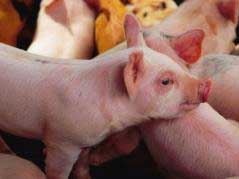|
Researchers Test Organic Vs. Inorganic Microminerals Fed To Pigs
URBANA, ILL.
Pigs require micromineral supplements in their diets to achieve optimal growth and health. However, feeding supplements that aren’t well digested can cause pigs to excrete excess minerals, which may reduce profits and also increase pollution to the external environment. Research from the University of Illinois may help swine producers decide which micromineral supplements are best for their pigs.
Microminerals can be fed in organic or inorganic forms. Organic microminerals may be produced by chelating mineral ions with organic molecules such as hydroxy methylthio butanoic acid (HMTBa) or glycine. Inorganic microminerals are metal salts such as sulfates or oxides.
“Our theory was that organic sources of microminerals are better digested by the pigs and result in less waste and more economical feeding,” said Hans H. Stein, a professor of animal sciences at the U of I.
Stein’s lab conducted an experiment to compare digestibility in organic sources of microminerals and inorganic sources fed to weanling pigs. They fed 48 growing pigs diets based on either corn and soybean meal, or a low mineral diet based on corn grits and sorghum. To these diets, they added one of three supplements: a supplement containing inorganic sources zinc, copper, manganese, and iron in the form of sulfates; a supplement containing organic sources of the same minerals chelated with HMTBa or glycine; or a basal supplement that did not contain any of these four microminerals.

Results indicated that responses to organic versus inorganic microminerals depended on the type of diet. When pigs were fed the corn-soybean meal diet supplemented with organic minerals, they had increased absorption, retention, and apparent total tract digestibility (ATTD) of zinc, copper, and manganese, as well as increased absorption and retention of iron compared with pigs fed the inorganic sources of minerals.
There was no difference in absorption, retention, or ATTD of microminerals for pigs fed corn grits and sorghum diets supplemented with organic or inorganic sources of minerals.
“Corn-soybean meal diets contain more phytic acid than corn grits diets,” Stein explained. “Minerals can form complexes with phytic acid that are indigestible by the pigs, but these results indicate that organic microminerals are less likely to form complexes. So, in a high-phytate diet, organic microminerals can improve ATTD and absorption of minerals.”
The paper, “Digestibility and retention of zinc, copper, manganese, iron, calcium, and phosphorus in pigs fed diets containing inorganic or organic minerals,” was published in a recent issue of the Journal of Animal Science. It was co-authored by Yanhong Liu of the University of Illinois along with Yulin Ma, Junmei Zhao, and Mercedes Vazquez-Añón of Novus International of St. Charles, Missouri.
Novus International provided financial support for the research. ∆
|
|